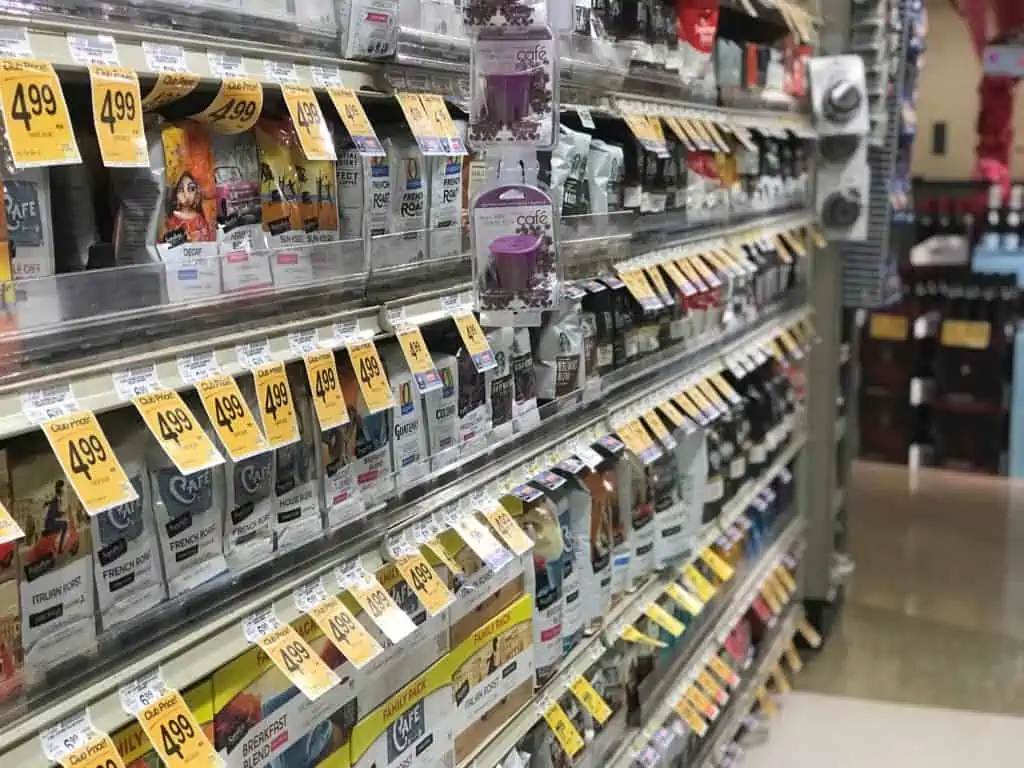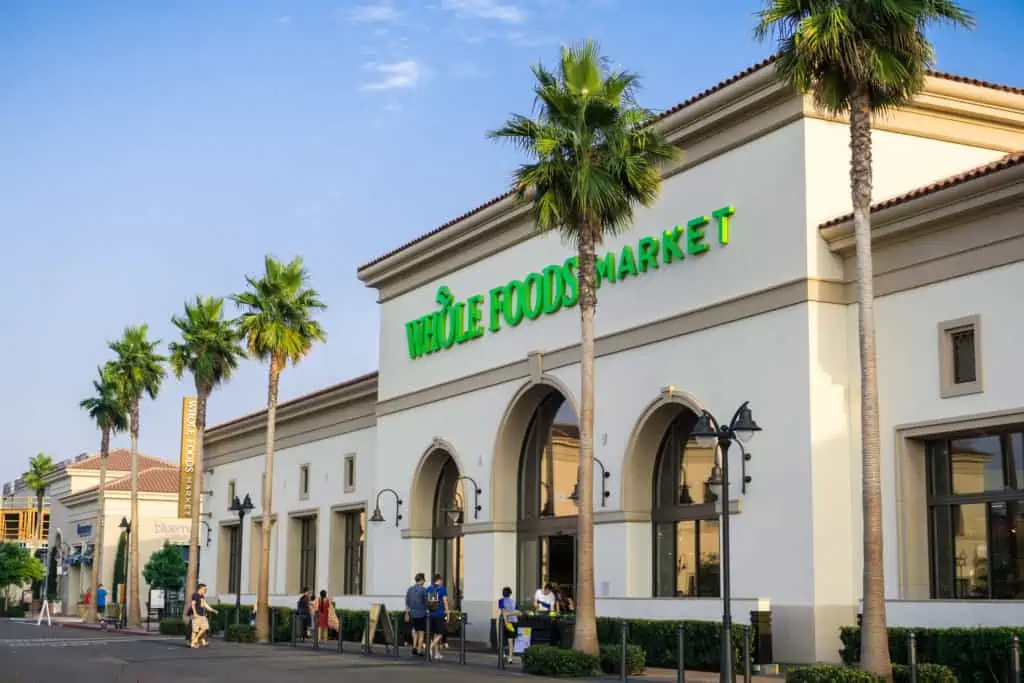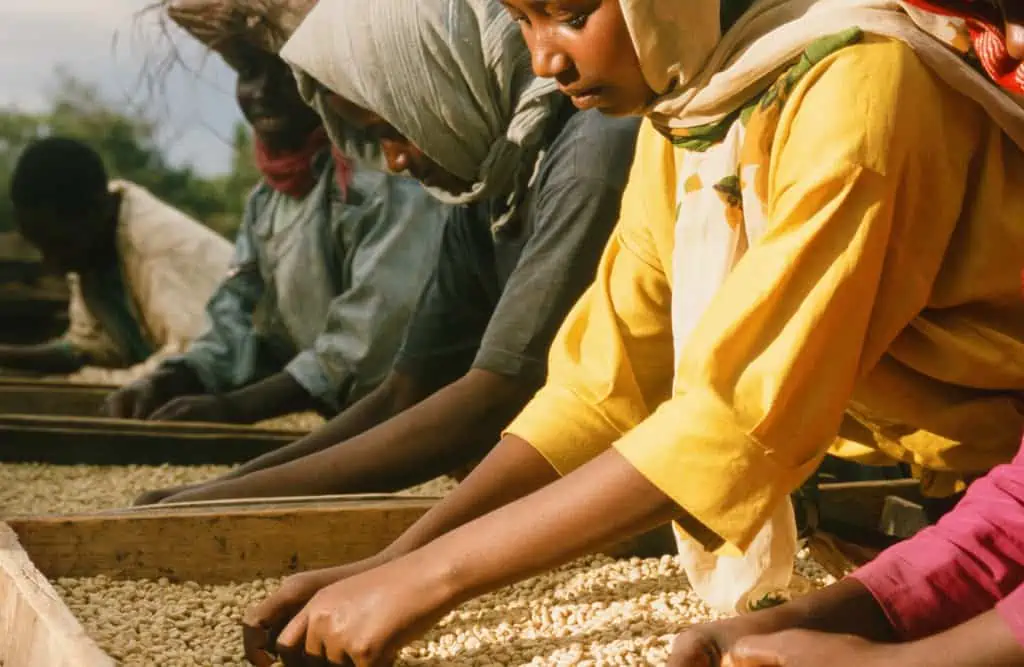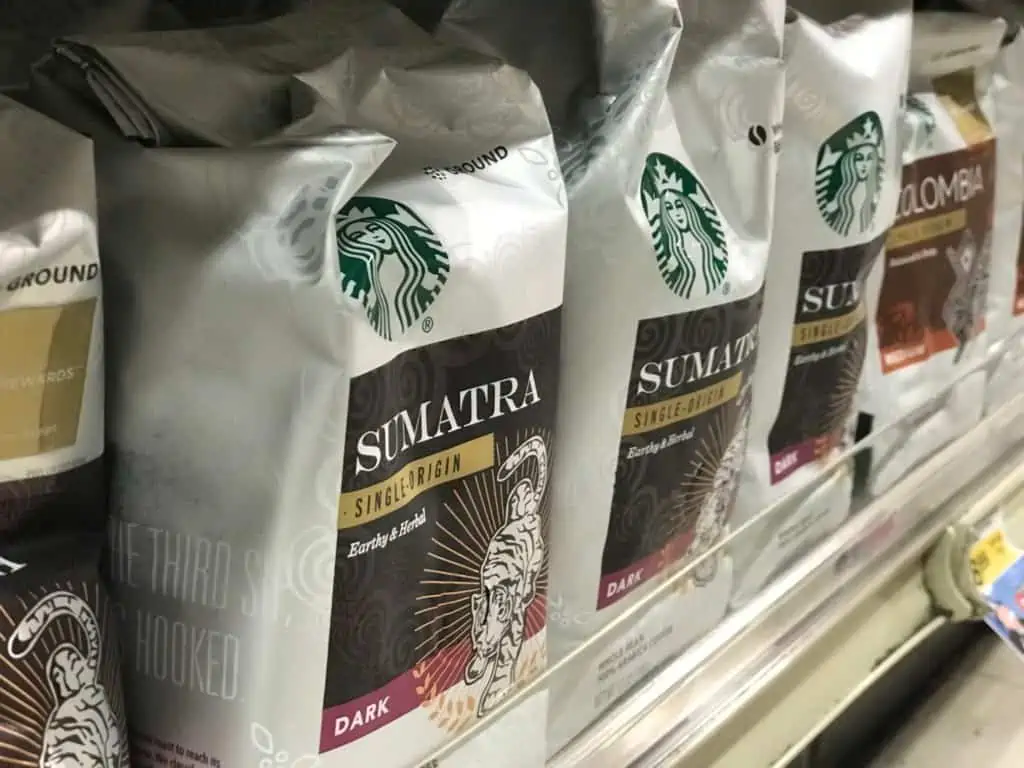
We track the specialty coffee industry obsessively, day in and day out, documenting its latest trends toward bespoke experiences (both at cafés and at home) and celebrating the farmers and roasters who are pushing the envelope of coffee experimentation and differentiation in unprecedented ways.
But what options are available to coffee-lovers who don’t have the time or inclination to order coffees online from artisanal roasters or stop by a local specialty roaster’s shop? Can they simply stroll the coffee aisle of their local chain supermarket and toss something into the cart with the rest of the week’s shopping that will light up their mornings with a similar excitement?
Starting Point: Single-Origin, Whole-Bean
Most of the coffees to which Coffee Review awards high ratings are produced on a single farm or in a single country; in other words, they are not blends. And almost all are sold as whole beans rather than pre-ground. So we made these our two main criteria for this report: We would buy coffees single-origin, whole-bean coffees available in large supermarket chains, the kinds of coffees Coffee Review readers might find particularly attractive. Our working hypothesis was that, as the specialty coffee market grows and the nationwide demand for more accessibility to locally sourced products on supermarket shelves increases, we would see more local roasters and distinctive coffees represented in supermarkets across the U.S. (As it turned out, there were a lot of locally roasted coffees available in the chains we visited, but most were blends and most of those were pre-ground. More on that later.)

Coffee aisle in a Safeway supermarket, Portland, Oregon. Courtesy of Ron Walters.
Where We Shopped
We cast a fairly wide net, sampling stores in four discrete geographical regions of the U.S.: northern California’s East Bay region; Winston-Salem, North Carolina and the suburb of Clemmons; Madison, Wisconsin; and the greater Chicago metropolitan area.
We tested 38 coffees for this report, all whole-bean single-origin and all purchased from supermarket shelves in the regions noted above. We tried to include as many of the big grocery chains as possible. We sampled coffees from Whole Foods (owned by Amazon) in Berkeley, California and in Winston-Salem, North Carolina; Mariano’s (owned by Kroger) and Jewel-Osco (owned by Albertsons) in Chicago; Publix (employee-owned) in Winston-Salem and Harris-Teeter (owned by Kroger) in Clemmons, North Carolina; Safeway (owned by Albertsons) in Oakland, California; Woodman’s (employee-owned) and Metro Market (owned by Kroger) in Madison, Wisconsin; Trader Joe’s (owned by T.A.C.T. Holding, Inc.) in Oakland, California; Costco (privately owned) in Albany, California; and Sprouts Farmers Market (owned by Apollo Global) in Oakland, California.
What We Found
Scores for the 38 tested samples ranged from 78 (well below specialty grade) to 93. Nine rated 90-93, and we review these 90+ samples in conjunction with this report. We also added reviews for five more coffees (four of them bargains) ranging in score from 87 to 89.
Here are the nine samples that topped 90:
Counter Culture Idido, 93 (Whole Foods Market, Berkeley; $14.99/12 ounces)
Equator Coffee Ethiopia FTO, 92 (Whole Foods Market, Berkeley; $17.99/12 ounces)
Larry’s Organic Ethiopia Sidamo, 92 (Whole Foods Market, Winston-Salem; $13.99/12 ounces)
Big Shoulders Colombia, 91 (Mariano’s, Chicago; $10.95/12 ounces)
3-19 Honduras Atanacio Nolasco, 90 (Whole Foods Market, Berkeley; $14.99/12 ounces)
Signature Reserve Sidamo Ethiopian Suke Quto, 90 (Safeway, Oakland; $11.29/12 ounces)
Joe Van Gogh Ethiopia Sidamo Natural, 90 (Whole Foods Market, Winston-Salem; $13.99/12 ounces)
Allegro Coffee Roasters Kenya Zuri, 90 (Whole Foods Market, Berkeley; $14.99/12 ounces)
Café Femenino Guatemala Dark Roast, 90 (Whole Foods Market, Winston-Salem; $13.99/12 ounces)
Here are five runners-up at 87-89. The first four represent impressive ratings-to-dollar values.
HT Traders Colombian Supremo, 89 (Harris-Teeter, Clemmons, North Carolina; $4.99/12 ounces)
Cameron’s Guatemala bulk, 89 (Woodman’s, Madison; $6.99/16 ounces)
8 O’Clock Colombia, 88 (Woodman’s, Madison; $9.29/22 ounces)
Hills Bros 100% Guatemalan, 87 (Woodman’s, Madison; $8.99/32 ounces
Starbucks Sumatra, 87 (Publix, Winston-Salem; $10.49/12 ounces)
Some Takeaways
An Edge for Whole Foods Markets. If you are shopping large food stores for single-origin, whole-bean coffees of high quality and distinctive character, you are most likely to find them at a Whole Foods Market. True, Whole Foods’ focus on specialty products may make them appear atypical as supermarkets, but their size, comprehensive range of offerings and wide national reach (around 500 stores nationally) clearly qualify them for the category. And they definitely support local coffee roasters. The Berkeley Whole Foods we shopped at had close to 20 local roasters on its shelves; the Winston-Salem store had roughly 10.

People shopping at the Whole Foods supermarket in Santa Clara, California.
What’s interesting about Whole Foods leading the local charge is that the brand has its own roasting operation under the labels Allegro and Allegro Coffee Roasters. The former is an imprint from the Thornton, Colorado headquarters, while the latter is a small-batch “craft” roastery with four locations: Berkeley, Chicago, Denver and New York. A spokesperson for Allegro said, “Whole Foods is committed to offering local coffees across our markets in addition to our own brand. Consumers should have a full range of choices available.”
The Ethiopia Edge. Five of this month’s nine highest-rated coffees were Ethiopias. Good news for supermarket specialty coffee shoppers, as Ethiopia produces some of the most exciting coffees in the world at affordable prices. Mixed news for Ethiopian coffee producers, who probably should be paid a bit more for their consistently exceptional coffees.

Women at drying table in Ethiopia. Courtesy of Kenneth Davids.
Pay More, Get Better Coffee. No surprise here, but our sampling generally confirmed that better coffees cost more. All of the 90+ coffees we review here sold roughly in the rating-to-price range that defines what we call “good value” coffees at Coffee Review, but none represented the flat-out bargains that many consumers associate with supermarkets. On the other hand, paying more did not necessarily assure a better coffee. There were some 83-point and 84-point disappointments among the locally roasted Whole Foods Market coffees, for example.
The Bargains. For the really good-deal coffees, we need to drop just a bit lower in the ratings. The 89-rated Cameron’s Guatemala is priced at a low $6.99/16 ounces bulk. We found it at one of the 18 locations of the independent, employee-owned, Wisconsin-based Woodman’s supermarket chain. The HT Trader’s Colombia (89) is also a bargain at $4.99/12 ounces; it is a store brand we purchased at one of the 260 Harris-Teeter Supermarkets located throughout the South Atlantic states. The 8 O’Clock Coffee brand has appeared on grocery store shelves continuously since 1859, when it originated with a company that eventually became the A&P chain of supermarkets. It is now an independent coffee brand still sold at a range of supermarkets, most of them in the eastern half of the country. At 88 points and $9.29 for 22 ounces, the 8 O’Clock Colombia we tested qualifies as another full-on value. Unlike many other long-established supermarket brands, 8 O’Clock has always offered the option of buying its coffees whole bean rather than pre-ground. The Hills Bros Guatemala, a point lower at 87, is another solid value at $8.99 for two pounds.
One Problem with Bargains. The potential shadow hovering over all of these solid but inexpensive coffees is the economic challenge faced by the farmers who produce them. Global coffee prices for consistent, good-quality green coffee are still close to all-time historical lows, suggesting that, at the far end of the supply chain, farmers and farm workers are involuntarily subsidizing some of the low retail prices cited here. Read more about the ongoing coffee price crisis here.
But Plenty of Sustainability-Oriented Certifications. Although at Coffee Review we find less and less emphasis on certifications like organic, fair trade and Rainforest Alliance among the coffees we report on (our 2017 report on organic-certified coffees from Africa hypothesizes about the reasons for this), roughly a third of the 38 coffees we cupped for this report displayed one or more certifications. Perhaps certifications are a more powerful market differentiator in a supermarket context, where coffees present themselves as relatively anonymous choices, whereas for a coffee-lover already considering paying top dollar for a micro-lot differentiated by tree variety and processing method, certification may come across as a minor selling point. And in the supermarket context, it’s likely that certifications are attractive to the same shoppers who routinely give preference to organic, fair trade produce. Supermarket News reported in May 2019 that organic sales rose 6.3% to $52.5 billion last year, breaking the $50 billion mark for the first time. Four of the nine 90+ coffees we review here carry either USDA Organic certification, fair trade certification, or both.
The Blends that Swallowed the Single-Origins. One of the striking findings of our survey was how the selection of single-origin coffees available in the supermarket appears to have shrunk to be replaced by blends. This makes sense, of course, given the importance of price in supermarket sales. It’s easier to trim cost while maintaining consistency if you can juggle coffees from various origins in a blend, rather than being limited to sourcing from one origin only. On the other hand, certain single-origin names have always constituted free brands that have accumulated great consumer loyalty over the years. So what do you do if you want to take advantage of that loyalty to certain famous origin names if you can’t buy enough good, characteristic coffee from those origins at prices that will help turn you a profit in the supermarket?

Starbucks Sumatra at a Safeway in Portland, Oregon. Courtesy of Ron Walters.
We found two coffees offered by Starbucks that are identified in large print on the front of the bag as representing certain well-known and admired single-origins: Kenya and Costa Rica. But a reading of the fine print on both bags reveals that they are actually blends that combine coffees from the headlined origins with similar coffees from neighboring origins, which are not named. We tested the Kenya blend and it was a pleasant enough coffee that we rated 89, but it did not read like a big, full-throated Kenya. We do review here, at 87, a true single-origin Starbucks coffee, a Sumatra, that appeared to have national distribution (we found it at Safeway in northern California and Portland, Oregon, and, as reviewed here, in a Publix supermarket in Winston-Salem, North Carolina).
The Freshness Conundrum. Finally, there’s the issue of freshness in supermarket coffees. One way to measure potential for freshness in a sealed coffee bag is to measure how much residual oxygen remains in the bag with the coffee before the consumer opens it. The more staling oxygen left in the bag, the more likely the aromatics may have faded. Coffees packaged with expensive, state-of-the-art equipment may show 0% oxygen at the point they are opened (true here of all of the Starbucks samples, the HT Traders Colombia, and the 8 O’Clock Colombia). Coffees not protected at all will show about the same amount of oxygen as in the atmosphere (around 21%). Most of the coffees we review here, those that did not display 0% oxygen, showed between 7% and 19%.
What appeared to be true for this month’s samples, however, is that the quality of the coffee inside the bags (plus perhaps the persistence of stores and suppliers in maintaining fresh inventory) seemed to be more important to netting a high-rated cup than the integrity of the packaging as reflected in % residual oxygen. All of the 90+-rated coffees showed 7% or more oxygen in the bag, one as high as 19%. On the other hand, none of the coffees that showed 0% residual oxygen made it to 90 points, and two (not listed here) showing 0% came in quite low at 84 and 85. It is true that the five top-rated samples for this month averaged 11.6% oxygen, whereas the four somewhat lower-rated of the nine averaged 17.25%. Significant? Perhaps. (See Kenneth Davids’ 2016 supermarket report for more about the influence of oxygen on freshness.)
Summing Up
It would appear, based on our limited survey of three regional markets, that unless you shop at a Whole Foods Market, you are not likely to find supermarket equivalents of the fine and varied single-origin coffees we celebrate at Coffee Review. But, if you do shop elsewhere and are satisfied with a solid, classic cup, you may find it in the form of certain single-origin Colombias, such as the 91-point Big Shoulders Colombia (Mariano’s, Chicago), the HT Traders 89-point Colombia (Harris-Teeter, in the South-Atlantic states) and the 8 O’Clock 88-point Colombia.
True, the selection of blends was much richer in the chains we shopped for this report than the selection of single-origins. But our assessment of those blends will have to wait until another year and another supermarket shopping spree.
(Thanks to Leslie Lowdermilk, Tim Coonan and Michael Johnson for help in purchasing coffees for this report.)










